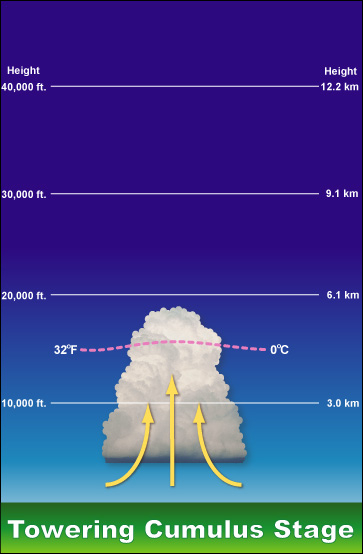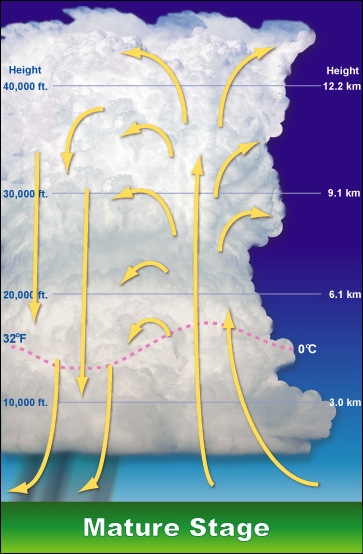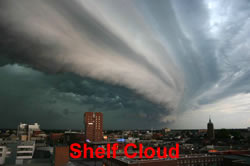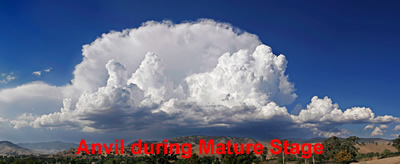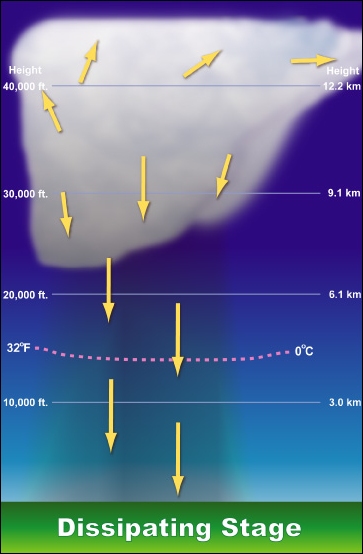A thunderstorm is a form of weather characterized by the presence of lightning and it’s effect, thunder. It is usually accompanied by heavy rain and sometimes snow, hail, or no precipitation at all.
Life Cycle of a Thunderstorm
Warm air has a lower density than cool air, so warm air rises within cooler air, similarly to hot air balloons. Clouds form as relatively warmer air carrying moisture rises within cooler air. As the moist air rises, it cools causing some of the water vapor in the rising packet of air to condense. When the moisture condenses, it releases energy so that the rising packet of air cools less than its surrounding air, so it continues to rise. If enough instability is present in the atmosphere, this process will continue long enough for cumulonimbus clouds to form, which support lightning and thunder. Generally, thunderstorms require three ingredients: (1) moisture, (2) an unstable airmass, and (3) a lifting force.
All thunderstorms, regardless of type, go through three stages: the cumulus stage, the mature stage, and the dissipation stage. Depending on the conditions present in the atmosphere, these three stages can take anywhere from 20 minutes to several hours to occur.
Cumulus Stage
The first stage of a thunderstorm is the cumulus stage, or developing stage. In this stage, masses of moisture are lifted upwards into the atmosphere. The trigger for this lift can be insolation heating the ground producing thermals, areas where two winds converge forcing air upwards, or where winds blow over terrain of increasing elevation. The moisture rapidly cools into liquid drops of water, which appears as cumulus clouds. As the water vapor condenses into liquid, latent heat is released which warms the air, causing it to become less dense than the surrounding dry air. The air tends to rise in an updraft through the process of convection (hence the term convective precipitation). This creates a low-pressure zone beneath the forming thunderstorm. In a typical thunderstorm, approximately 5×108 kg of water vapor are lifted, and the amount of energy released when this condenses is about equal to the energy used by a city (US-2002) of 100,000 during a month.
Mature Stage
In the mature stage of a thunderstorm, the warmed air continues to rise until it reaches existing air which is warmer, and the air can rise no further. Often this ‘cap’ is the tropopause. The air is instead forced to spread out, giving the storm a characteristic anvil shape. The resulting cloud is called cumulonimbus incus. The water droplets coalesce into larger and heavier droplets and freeze to become ice particles. As these fall they melt to become rain. If the updraft is strong enough, the droplets are held aloft long enough to be so large that they do not melt completely and fall as hail. While updrafts are still present, the falling rain creates downdrafts as well. The simultaneous presence of both an updraft and downdrafts marks the mature stage of the storm, and during this stage considerable internal turbulence can occur in the storm system, which sometimes manifests as strong winds, severe lightning, and even tornadoes.
Typically, if there is little wind shear, the storm will rapidly enter the dissipating stage and ‘rain itself out’, but if there is sufficient change in wind speed and/or direction the downdraft will be separated from the updraft, and the storm may become a supercell, and the mature stage can sustain itself for several hours.
In certain cases however, even with little wind shear, if there is enough atmospheric support and instability in place for the thunderstorm to feed on, it may even maintain its mature stage a bit longer than most storms.
Dissipating Stage
In the dissipation stage, the thunderstorm is dominated by the downdraft. If atmospheric conditions do not support super cellular development, this stage occurs rather quickly, approximately 20-30 minutes into the life of the thunderstorm. The downdraft will push down out of the thunderstorm, hit the ground and spread out. The cool air carried to the ground by the downdraft cuts off the inflow of the thunderstorm, the updraft disappears and the thunderstorm will dissipate.
Lightning
Lightning is an electrical discharge that occurs in a thunderstorm. It can be seen in the form of a bright streak (or bolt) from the sky. Lightning occurs when an electrical charge is built up within a cloud, due to static electricity generated by super cooled water droplets colliding with ice crystals near the freezing level. When a large enough charge is built up, a large discharge will occur and can be seen as lightning. The temperature of a lightning bolt can be five times hotter than the surface of the sun. Although the lightning is extremely hot, the duration is short and 90% of strike victims survive. Contrary to the popular idea that lightning does not strike twice in the same spot, some people have been struck by lightning over three times, and skyscrapers like the Empire State Building have been struck numerous times in the same storm. The loud bang that is heard is the super heated air around the lightning bolt expanding at the speed of sound. Because sound travels much more slowly than light the flash is seen before the bang, although both occur at the same moment. There are several types of lightning:
- In-cloud lightning is the most common. It is lightning within a cloud and is sometimes called intra-cloud or sheet lightning.
- Cloud to ground lightning is when a bolt of lightning from a cloud strikes the ground. This form poses the greatest threat to life and property.
- Ground to cloud lightning is when a lightning bolt is induced from the ground to the cloud.
- Cloud to cloud lightning is rarely seen and is when a bolt of lightning arcs from one cloud to another.
- Ball lightning is extremely rare and has several hypothesized explanations. It is seen in the form of a 20 to 200 centimeter ball.
- Cloud to air lightning is when lightning from a cloud hits air of a different charge.
- Dry lightning is a misnomer which can refer to a thunderstorm whose precipitation does not reach the ground.
- Heat Lightning is a misnomer of a lightning flash that is seen from the horizon that does not have accompanying thunder.
What To Do Before a Thunderstorm
To prepare for a thunderstorm, you should do the following:
- Remove dead or rotting trees and branches that could fall and cause injury or damage during a severe
thunderstorm. - “If thunder roars, go indoors” because no place outside is safe when lightning is in the area. We
want everyone to stay indoors until 30 minutes have passed after they hear the last clap of thunder.
Summary of Lightening Safety Tips for Inside the Home:
- Avoid contact with corded phones.
- Avoid contact with electrical equipment or cords. If you plan to unplug any electronic equipment, do so well before the storm arrives.
- Avoid contact with plumbing. Do not wash your hands, do not take a shower, do not wash dishes, and do not do laundry.
- Stay away from windows and doors, and stay off porches.
- Do not lie on concrete floors and do not lean against concrete walls.
The following are guidelines for what you should do if a thunderstorm is likely in your area:
- Postpone outdoor activities.
- Get inside a home, building, or hard top automobile (not a convertible). Although you may be injured if lightning strikes your car, you are much safer inside a vehicle than outside.
- Remember, rubber-soled shoes and rubber tires provide NO protection from lightning. However, the steel frame of a hard-topped vehicle provides increased protection if you are not touching metal.
- Secure outdoor objects that could blow away or cause damage.
- Shutter windows and secure outside doors. If shutters are not available, close window blinds, shades, or curtains.
- Avoid showering or bathing. Plumbing and bathroom fixtures can conduct electricity.
- Use a corded telephone only for emergencies. Cordless and cellular telephones are safe to use.
- Unplug appliances and other electrical items such as computers and turn off air conditioners. Power surges from lightning can cause serious damage.
- Use your battery-operated NOAA Weather Radio for updates from local officials.
Avoid the following:
- Natural lightning rods such as a tall, isolated tree in an open area.
- Hilltops, open fields, the beach, or a boat on the water.
- Isolated sheds or other small structures in open areas.
- Anything metal—tractors, farm equipment, motorcycles, golf carts, golf clubs, and bicycles.
Actions if outside:
Additional Information
| Name | Size | Version |
|---|---|---|
| Name | Size | Version |
| 1997-2006 Fatalities+Rates | 97 KB | |
| Lightning Safety Facts | 22 KB | |
| LightningMyths-1 | 43 KB |


